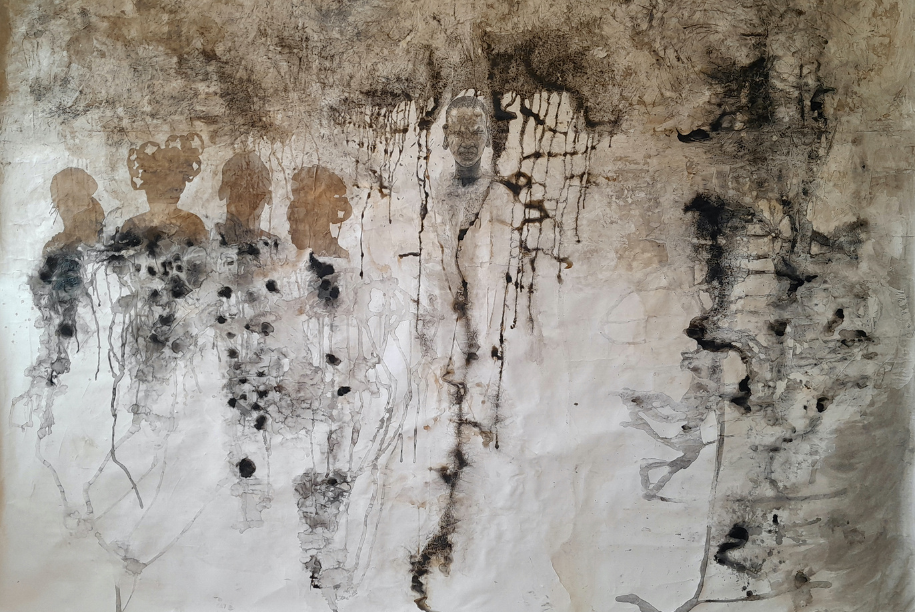Stanley Wany Corps matériels

© Stanley Wany, 2025
Corps matériels marks a symbolic return to artist Stanley Wany's ancestral roots, following the paths of memory leading to Ilé-Ifẹ̀, the founding city of Yoruba cosmology. As the mythical cradle of West African divinities and cultures, Ifẹ̀ here becomes a starting point for a wider exploration of the African continent, in search of buried or fragmented traces that have resisted the dispossessions of the transatlantic slave trade and the violence of colonial history, particularly in the regions once inhabited by the BaKongo peoples.
Rooted in an approach that is both intuitive and documented, the exhibition is based on research combining oral stories, academic knowledge and texts by African authors. If a geographical and historical distance separates the artist from these heritages, it is crossed by the mobile persistence of objects - those fragments of material memory now preserved in museums in North America. Wany has been inspired by these encounters with artifacts to produce a series of works that resonate with the forms, forces and aesthetics of the original cultures.
Corps matériels thus engages a dialogue between the tangible memory of objects and the intangible flows of the African diaspora. It questions the way in which symbols, imaginaries and energies have circulated across the ocean - that “Ethiopian sea” that Paul Gilroy, in The Black Atlantic (1993), calls a space for cultural transfers and creations. The exhibition is punctuated by an original performance conceived in collaboration with the Franco-Congolese artist Michèle Magema, also curator of the project, which extends this sensitive and political journey by activating bodies and gestures.

© Stanley Wany, 2025
Stanley Wany is a multidisciplinary artist whose work involves revisiting colonial and historical archives with the aim of unearthing the history of his Afrodescendant ancestors. He began his exploration as an editor and creator of experimental graphic novels that explore the non-linearity of narrative and the unconscious. After a residency in Finland, he made the leap into the visual arts, continuing his research by incorporating the historicity of narratives present in popular culture. Through drawing, painting, installation and experimental graphic novels, he deepens his reflections on popular culture, myths and the subconscious in relation to the experience of Afro-descendants in Western society.
Michèle Magema is a French-Congolese visual artist, born in 1977 in Kinshasa. She graduated in 2002 from the École Nationale Supérieure d’Arts de Paris-Cergy (DNSEP) and has been living and working in Montreal since 2022. Her interdisciplinary practice—spanning video, performance, photography, drawing, and installation—questions narratives and the memory of colonial histories, oral traditions, as well as intersectional and decolonial feminisms. She has built a solid international career, exhibiting at institutions such as the Brooklyn Museum in New York, the Centre Pompidou in Paris, and the Hayward Gallery in London, among others. In 2004, she was awarded the First Prize at the Dakar Biennale for Oyé Oyé, a striking dual-channel video installation. Her works are held in prestigious collections, including the Sindika Dokolo Collection in Luanda (Angola), the Contemporary Art / AfricaMuseum in Belgium, the FRAC Centre-Val de Loire in France, the Museum Rietberg in Zurich, and the Attijariwafa Bank Foundation in Morocco. She is a full professor at the École des Arts Visuels et Médiatiques (UQAM). Co-founder of the USANII space, she is also an exhibition curator. She is currently pursuing her doctoral studies within the DEPA program at UQAM.

© Stanley Wany, view from the exhibition Corps matériels, from October 4 to November 29, 2025. Photo: Michael Patten

© Stanley Wany, view from the exhibition Corps matériels, from October 4 to November 29, 2025. Photo: Michael Patten

© Stanley Wany, view from the exhibition Corps matériels, from October 4 to November 29, 2025. Photo: Michael Patten

© Stanley Wany, view from the exhibition Corps matériels, from October 4 to November 29, 2025. Photo: Michael Patten

© Stanley Wany, view from the exhibition Corps matériels, from October 4 to November 29, 2025. Photo: Michael Patten

© Stanley Wany, view from the exhibition Corps matériels, from October 4 to November 29, 2025. Photo: Michael Patten

© Stanley Wany, view from the exhibition Corps matériels, from October 4 to November 29, 2025. Photo: Michael Patten

© Stanley Wany, view from the exhibition Corps matériels, from October 4 to November 29, 2025. Photo: Michael Patten

© Stanley Wany, view from the exhibition Corps matériels, from October 4 to November 29, 2025. Photo: Michael Patten

© Stanley Wany, view from the exhibition Corps matériels, from October 4 to November 29, 2025. Photo: Michael Patten

© Stanley Wany, view from the exhibition Corps matériels, from October 4 to November 29, 2025. Photo: Michael Patten

© Stanley Wany, view from the exhibition Corps matériels, from October 4 to November 29, 2025. Photo: Michael Patten

© Stanley Wany, view from the exhibition Corps matériels, from October 4 to November 29, 2025. Photo: Michael Patten

© Stanley Wany, view from the exhibition Corps matériels, from October 4 to November 29, 2025. Photo: Michael Patten

© Stanley Wany, view from the exhibition Corps matériels, from October 4 to November 29, 2025. Photo: Michael Patten

© Stanley Wany, view from the exhibition Corps matériels, from October 4 to November 29, 2025. Photo: Michael Patten

© Stanley Wany, view from the exhibition Corps matériels, from October 4 to November 29, 2025. Photo: Michael Patten